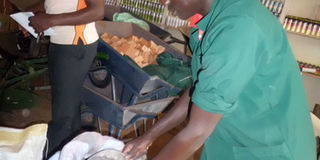Should you rethink your fertiliser management practices?

Tororo District Farmers Association members display fertilisers at their stall. Photo by Lominda Afedraru
What you need to know:
- Chemical fertiliser use has contributed significantly to increased global food output, especially in climatically favourable regions of the world. However, in northern Uganda, fertiliser use has been low.
- Fertiliser use efficiency is central to the best management practices, which embraces right source, right place, right timing and right application method. In this report, Lominda Afedraru highlights best management practices.
Northern Uganda, which has vast tracts of uncultivated land and where most of the population are subsistence farmers, has traditionally lagged behind other regions when it comes to fertiliser use.
According to findings released by NU-TEC market development programme, Uganda has the lowest fertiliser use in the East African region yet northern Uganda, which has been through the tribulations of the Lord’s Resistance Army insurgency, is adapting slowly.
Collins Apuoyo, the team leader of NU-TEC programme, explains that the current size of fertiliser market in northern Uganda is 6,083 metric tonnes annually although it is estimated to grow by 50 per cent over the next five years.
Out of this, 92 per cent of the fertilisers is consumed by contract farming schemes and commercial farmers.
Apuoyo says that challenges abound on fertiliser use and yet the scope is limited to mainly maize and rice farmers, a thing he admits can be changed through sensitisation.
Alex Utut, the senior agricultural inspector at the Ministry of Agriculture, Animal Industry and Fisheries, tips farmers on how to get the best out of fertiliser use.
Timing
Utut says that Diammonium phosphate (DAP), which is the world’s most widely used phosphorus fertiliser, must be applied at planting to enhance root growth of the plant.
Since it contains phosphorus for root growth, it will supply the plant with enough food. The nitrogen capacity is good for green leaf growth to enable photosynthesis to take place.
He adds that Urea, which contains enough nitrogen ought to be applied after first weeding of the plants.
Since it is in granular form, it is important for the farmer to avoid physical contact with the fertiliser by putting on gloves to avoid burning of the skin.
He suggests that a farmers should put a small drop measured in soda bottles close to the root of the plant, especially if applied on maize. But for rice, which is planted by broadcast, urea should also be broadcasted as well.
He asserts that timing is crucial when applying fertilisers.
Fertilisers that contain nitrogen, he advises, should applied when the soil is moist to avoid evaporation during the hot seasons.
Side banding
According to Utut, placing your nutrients close to your seed always comes with a risk of nitrogen seed burn.
In band or what is known as starter application, fertiliser is applied in bands near where developing roots will easily reach it; either to the side and below the seed rows, slightly below the seeds or in between the rows.
Utut says the best practice is to band fertiliser two inches to the side and two inches deeper than the seeds or plants. This provides the plants with a concentrated zone of nutrients and can improve nutrient use efficiency. The process can be done before or simultaneous with planting or seed drilling.
Several side banding openers are available to provide adequate nitrogen separation. This method can also be used for sulphur, potash and phosphate application.
Broadcasting
Surface broadcasting where fertiliser is applied on the surface across an entire field is often used with spin dry fertiliser or liquid fertiliser on the soil surface or on a growing crop.
Tillage during conventional seeding operations may be sufficient to incorporate Urea. If fertiliser is left on the soil surface, there is a risk that nitrogen will be lost due to evaporation.
Utut says that the addition of one-third to one-half of the total nitrogen requirement in the seed row can improve the overall Nitrogen use efficiency of the broadcasting method.
Potash and Sulphur products can be effectively broadcasted and studies have shown that phosphate is only 20–30 per cent as effective as when it is side banded.
Quantity
In the case of cereal crops such as maize and rice, the farmer must know the exact quantity to be applied.
He recommends applying 50kg of DAP per hectare while Urea should be 25kg per hectare.
He reasons that inorganic fertiliser contains no carbon unlike organic, thus the huge requirements.
Organic vs chemical
Organic fertiliser is basically decomposed organic material while inorganic fertilisers also known as synthetic or chemical are factory made products which are added in the soil to enhance plants.
Organic fertilisers comprise of compost and crop residues. They are naturally occurring such as animal wastes from meat processing, peat, manure, slurry, and guano.
Inorganic nitrogen fertilisers come in many different forms, such as ammonium nitrate, potassium nitrate, calcium nitrate and urea.
These fertilisers contain high levels of nitrogen, one of the most vital nutrients for plant growth. Utut says that whereas farmers can use both types of fertilisers, the use of inorganic fertiliser quickly improves yields and soil fertility.
Desired
Inorganic nitrogen fertilisers come in many different forms, such as ammonium nitrate, potassium nitrate, calcium nitrate and urea. These fertilisers contain high levels of nitrogen, one of the most vital nutrients for plant growth.
Utut says that whereas farmers can use both types of fertilisers, the use of inorganic fertiliser quickly improves yields and soil fertility.




